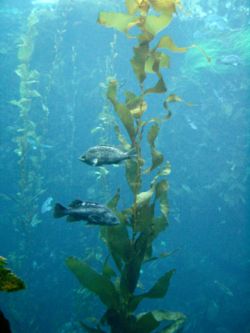
Ecosystem engineer
Encyclopedia


Organism
In biology, an organism is any contiguous living system . In at least some form, all organisms are capable of response to stimuli, reproduction, growth and development, and maintenance of homoeostasis as a stable whole.An organism may either be unicellular or, as in the case of humans, comprise...
that creates or modifies habitats
Habitat (ecology)
A habitat is an ecological or environmental area that is inhabited by a particular species of animal, plant or other type of organism...
. Jones et al. (1994) identified two different types of ecosystem engineers:
- Allogenic engineers modify the environmentEnvironment (biophysical)The biophysical environment is the combined modeling of the physical environment and the biological life forms within the environment, and includes all variables, parameters as well as conditions and modes inside the Earth's biosphere. The biophysical environment can be divided into two categories:...
by mechanically changing materials from one form to another. BeaverBeaverThe beaver is a primarily nocturnal, large, semi-aquatic rodent. Castor includes two extant species, North American Beaver and Eurasian Beaver . Beavers are known for building dams, canals, and lodges . They are the second-largest rodent in the world...
s are archetypal ecosystem engineers; in the process of clearcuttingClearcuttingClearcutting, or clearfelling, is a controversial forestry/logging practice in which most or all trees in an area are uniformly cut down. Clearcutting, along with shelterwood and seed tree harvests, is used by foresters to create certain types of forest ecosystems and to promote select species that...
and damming, beavers alter their ecosystemEcosystemAn ecosystem is a biological environment consisting of all the organisms living in a particular area, as well as all the nonliving , physical components of the environment with which the organisms interact, such as air, soil, water and sunlight....
extensively. Different types and numbers of other organisms will thrive in the region of a beaver dam than would in a non-dammed region. CaterpillarCaterpillarCaterpillars are the larval form of members of the order Lepidoptera . They are mostly herbivorous in food habit, although some species are insectivorous. Caterpillars are voracious feeders and many of them are considered to be pests in agriculture...
s that create shelters from leaves are also creating shelters for other organisms which may occupy them either simultaneously or subsequently.
- Autogenic engineers modify the environment by modifying themselves. As trees grow, their trunks and branches create habitats for other living things. In the tropics, lianaLianaA liana is any of various long-stemmed, woody vines that are rooted in the soil at ground level and use trees, as well as other means of vertical support, to climb up to the canopy to get access to well-lit areas of the forest. Lianas are especially characteristic of tropical moist deciduous...
s connect trees, which allow many animals to travel exclusively through the forest canopy.
Humans are very significant allogenic engineers, though this interaction is more studied in the field of human ecology
Human ecology
Human ecology is the subdiscipline of ecology that focuses on humans. More broadly, it is an interdisciplinary and transdisciplinary study of the relationship between humans and their natural, social, and built environments. The term 'human ecology' first appeared in a sociological study in 1921...
.
Introduced species
Introduced species
An introduced species — or neozoon, alien, exotic, non-indigenous, or non-native species, or simply an introduction, is a species living outside its indigenous or native distributional range, and has arrived in an ecosystem or plant community by human activity, either deliberate or accidental...
are often ecosystem engineers. Kudzu
Kudzu
Kudzu is a plant in the genus Pueraria in the pea family Fabaceae, subfamily Faboideae. It is a climbing, coiling, and trailing vine native to southern Japan and southeast China. Its name comes from the Japanese name for the plant, . It is a weed that climbs over trees or shrubs and grows so...
, a leguminous plant introduced to the southeast U.S., changes the distribution and number of animal and bird species in the areas it invades. It also crowds out native plant species. The zebra mussel
Zebra mussel
The zebra mussel, Dreissena polymorpha, is a small freshwater mussel. This species was originally native to the lakes of southeast Russia being first described in 1769 by a German zoologist Peter Simon Pallas in the Ural, Volga and Dnieper rivers. They are still found nearby, as Pontic and Caspian...
is an ecosystem engineer in North America. By providing refuge from predators, it encourages the growth of freshwater invertebrate
Invertebrate
An invertebrate is an animal without a backbone. The group includes 97% of all animal species – all animals except those in the chordate subphylum Vertebrata .Invertebrates form a paraphyletic group...
s through increasing microhabitats. Light penetration into infected lakes also improves, resulting in an increase in algae
Algae
Algae are a large and diverse group of simple, typically autotrophic organisms, ranging from unicellular to multicellular forms, such as the giant kelps that grow to 65 meters in length. They are photosynthetic like plants, and "simple" because their tissues are not organized into the many...
.

